Hassani S. Mathematical Physics: A Modern Introduction to Its Foundations
Подождите немного. Документ загружается.

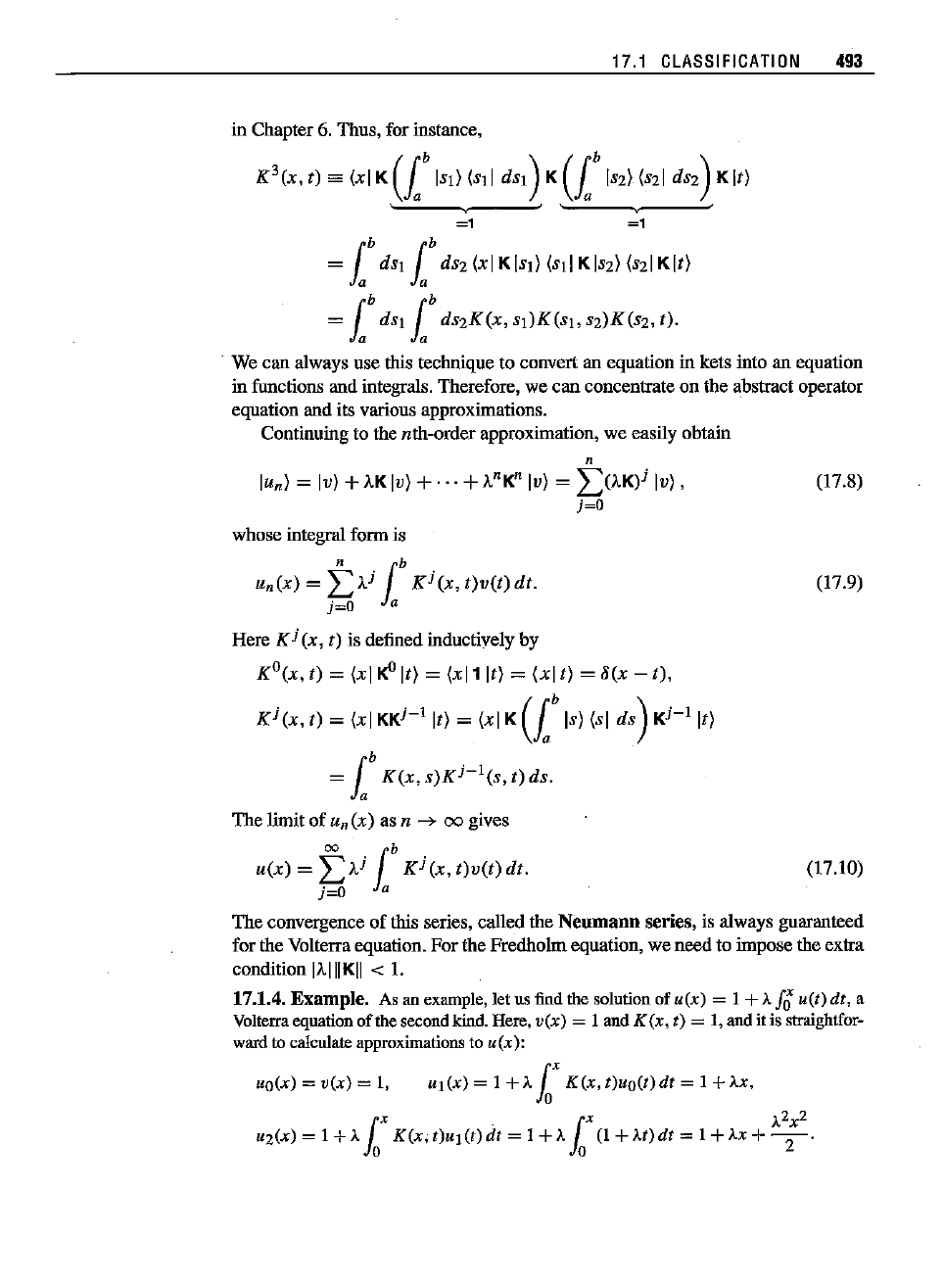
17.1 CLASSIFICATION 493
in Chapter 6. Thus, for instance,
K
3(x,
t)
sa
(xl
K(l
b
IsIl (sll
dSI)K
(l
b
IS2)
(s21
dS2)
Kit}
n
Iu
n
}
= Iv}
+).K
[u) +
...
+ ).nK
n
Iv} =
L().K)i
Iv} ,
i~O
whose integral form is
(17.8)
(17.9)
Un(x) =
t).i
l
b
Ki(x,t)v(t)dt.
j=O
a
Here Ki (x, t) is defined inductively by
KO(x, z) = (xl
~
It) =
(xI1It)
=
(xl
t) =
8(x
-
t),
Ki (x, t) = (xl
KKi-
1
It) = (xl K
(l
b
Is) (si
dS)
Ki-
I
It}
= l
b
K(x,s)Ki-l(s,t)ds.
The limit
of
Un
(x)
as n
->
00
gives
u(x)
=
f).i
l
b
Ki(x,
t)v(t)dt.
(17.10)
j=O
a
The
convergence
of
this series, called the Neumann series, is always guaranteed
for the Volterra equation.
For
the Fredholmequation, we
need
to impose the extra
condition
1).IIIKIl
< 1.
17.1.4. Example. As an example, let us find the solution of u(x) = 1
+).
f
o
u(t) dt, a
Volterra equation of the second kind. Here,
v(x) = I and K(x, t) = 1, and it is straightfor-
ward
to
calculate
approximations
to u(x):
Uo(x)
=v(x) =1,
UI(X)
=1
+A
foX
K(x,t)uo(t)dt
=1 +AX,
{X . (X
A2X2
U2(X)
=1
+A
10
K(x,t)uI(t)dt
= 1
+A
10
(I
+M)dt
=I +AX +
-2-'

494 17.
INTEGRAL
EQUATIONS
It is
clear
that the
nth
term will
look
like
).,2
x2
).}lXn
n
)jx
i
u,,(x) =
l+h+--+
...
+-,-
= L-.,-.
2 n.
j=O
J.
As n --+
00,
we obtain
u(x)
= e
Ax
• By direct substitution, it is readily checked that this is
indeed a solution of the original integral equation. II
17.2 Fredholm Integral Equations
We can use our knowledge
of
compactoperators gainedin the previous chapter to
study Fredholm equations
of
the secondkind. With A "" 0 a complex number, we
consider the characteristic equation
(l-AK)lu)
= Iv), or
u(x)
-
AK[u](x)
=
v(x),
(17.11)
where
all fuuctious are square-integrable on [a, bl, and
K(x,
t), the
Hilbert-
Schmidtkernel, is square-integrable on the rectangle [a, bl x [a, b].
Using Propositiou 16.2.9, we innnediately see that Equation (17.11) has a
unique solutiou if
IAIIiKIl
< I,
and
the solutiou is
of
theform
00
lu) = (1 - AK)-llv) =
LA"K"
Iv),
n=O
(17.12)
or
u(x)
=
L~oAnK"[vl(x),
where
Kn[v](x)
is defined as in Equation (17.4)
except that now
b replaces x as the upper limit
of
integration.
17.2.1.
Example.
Considerthe integralequation
u(x)
-
10
1
K(x,
t)u(t)
dt = x, where
{
X
ifO~x
<t,
K(x,
r) = t
ift
<x::::::
l.
Here )" = 1; therefore, a Neumann series solution exists if
IIKIf
< 1.
It
is convenient to
write K
in terms
of
the thetafunction:
1
K(x,
t) = xO(t - x) +
to(x
- r),
(17.13)
This gives
IK(x, t)1
2
= x
20Ct
- x) +t
20(x
- t) because 02(x - t) = O(x - t) aod
O(x - t)O(t - x) =
O.
Thus,we have
IIKII
2
= f
dx
f
dtIK(x,
t)1
2
=
fo1dx
folx20Ct-X)dt+
fo1dx
fo
1t2
0(X-t)dt
[I
r
[I
r
[I
(t3)
[I
(x
3
)
1
= fo dt fo x
2
dx +f
o
dx
f
o
t
2
dt = f
o
dt
"3
+fo dx 3" = 6'
1Recall
that
the theta function is defined to be 1
if
its argument is positive, and 0
if
it is negative.

17.2
FREDHOLM
INTEGRAL
EQUATIONS
495
Sincethisis less
than
I, the
Neumann
series
converges,
andwehave
2
u(x)
=
I»
l
b
Ki(x,t)v(t)dt=
flo
l
Ki(x,t)tdt=
ffi(x).
j=O
a j=O 0
j=O
The firstfew terms areevaluatedas follows:
fo(x) =
10
1
KO(x,t)tdt
=
10
1
8(x,t)tdt
=x
!J(x)
=
(I
K(x,t)tdt=
(I[X8(t-X)+t8(x-t)]tdt
.
10
1
0
=x 1
1
t
dt
+
(X
t2
dt
=
::
_ x
3
.
x 1
0
2 6
Thenextterm is
trickier
than
the
first
two
because
ofthe
product
ofthe
theta
functions.
We first substitute Equation (17.13) in the integral for the second-order term, and simplify
h(x)
=
10
1
K
2(x,t)tdt
=
10
1
tdt
10
1
K(x,s)K(s,t)ds
=
10
1
t dt
10
1
[x8(s - x) +sO(x - s)][sO(t - s) +tOrs - t)] ds
=x
10
1
tdt
10
1
sO(s-x)8(t-s)ds+x
10
1
t
2dt
10
1
O(s-x)8(s-t)ds
+
(\dt
(I
s2
0(x-s)8(t-s)ds+
(I
t2dt
(\O(X-s)O(s-t)ds.
1
0
10
.
10
10
Itis convenientto
switch
the
order
of
integration
atthispoint, Thisis
because
ofthe
presence
ofO(x - s) and O(s
-x),
which do not involve t and are bestintegrated last. Thus, we have
h(x)
=X
10
1
s8(s-x)ds
/,1
tdt+x
10
1
8(s-x)ds
loS
t
2dt
+
foIS20(X-S)dS
/,I
t d
t+
foIS8(X-S)dS
fo
St
2dt
=x1IsdS(~_s2)+x11
ds
s3
+
(Xs2dS(~_s2)+
f'sds
s3
x 2 2 x 3
10
2 2 1
0
3
5 1 3 1 5
=-x--x
+-x
24 12 120
As a test of his/her knowledge of O-function manipulation, the reader is orged to perform
the
integration
in
reverse
order.
Addingalltheterms, we
obtain
an
approximation
foru(x)
that
is validfor0::: x
:::
1:
II
2Note
that
inthiscase
(Fredholm
equation),
wecan
calculate
the
jth
terminisolation. In the
Volterra
case,itwasmore
natural
to
calculate
thesolutionup to agiven
order.
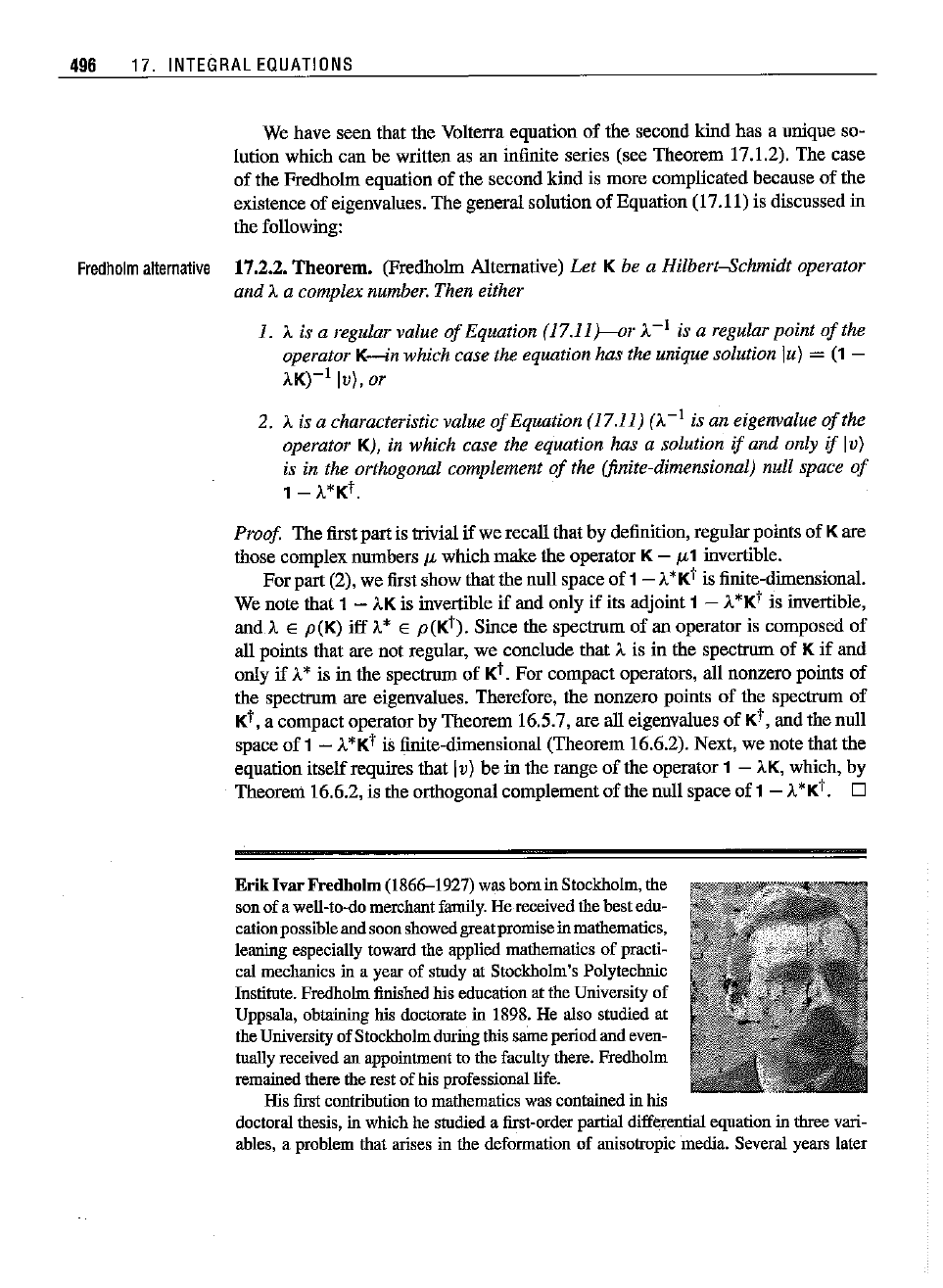
496 17.
INTEGRAL
EQUATIONS
We have seen that the Volterra equation of the second kind has a unique so-
lution which can be written as an infinite series (see Theorem 17.1.2). The case
of the Fredholm equation
of
the second kind is more complicated because of the
existence
of
eigenvalues. The general solution of Equation (17.11) is discussed in
the following:
Fredholm
alternative
17.2.2.
Theorem.
(Fredhohn Alternative) Let K be a Hilbert-Schmidt operator
and
A a complex number. Then either
1. A is a regular value
of
Equation (17.11)---or A
-I
is a regular point
ofthe
operator
K-in
which case the equation has the unique solution lu) = (1 -
AK)-I Iv), or
2. A is a characteristic value
of
Equation (17.11) (A
-1
is an eigenvalue
ofthe
operator K), in which case the equation has a solution if and only if Iv)
is in the orthogonal complement
of
the (finite-dimensional) null space
of
1-A*Kt.
Proof The first partis trivial if we recall that by definition, regularpoints of Kare
those complex numbers
fl. which make the operator K-
fl.1
invertible.
For
part (2), we first show that the null space of 1 - A*Kt is finite-dimensional.
We note that 1 -
AK
is invertible if and only if its adjoint 1 - A*Kt is invertible,
and A
E P(K) iff
1.*
E P(Kt). Since the specttum of an operator is composed of
all points that are not regular, we conclude that A is in the specttum of K
if
and
only
if
1.*
is in the specttum of Kt. For compact operators, all nonzero points of
the specttum are eigenvalues. Therefore, the nonzero points of the specttum of
Kt, a compactoperator by Theorem 16.5.7, are all eigenvalues
of
Kt, and the nnll
space
of
1 - A*Kt is finite-dimensional (Theorem 16.6.2). Next, we note that the
equation itselfrequires that
Iv) be in the range
of
the operator 1 -
AK,
which, by
Theorem 16.6.2, is the orthogonal complement
of
the nnll space
of1
- A*Kt. D
Erik
IvarFredholm (1866-1927) was born inStockholm, the
sonof awell-to-do
merchant
family.
He
received
thebestedu-
cationpossibleandsoonshowedgreatpromiseinmathematics,
leaningespecially
toward
the
applied
mathematics
of
practi-
cal mechanics in a year
of
study at Stockholm's Polytechnic
Institute.
Fredholm
finished
his
education
attheUniversity of
Uppsala, obtaining his doctorate in 1898. He also studied at
the
University
of
Stockholm
during
thissameperiodandeven-
tuallyreceivedan
appointment
to the
faculty
there.
Fredholm
remained
there
therestof hisprofessional life.
His
first
contribution
to
mathematics
was
contained
inhis
doctoral
thesis,in whichhe
studied
a
first-order
partial
differential
equation
in
three
vari-
ables, a
problem
that
arises
in the
deformation
of
anisotropic
'media.
Several
years
later
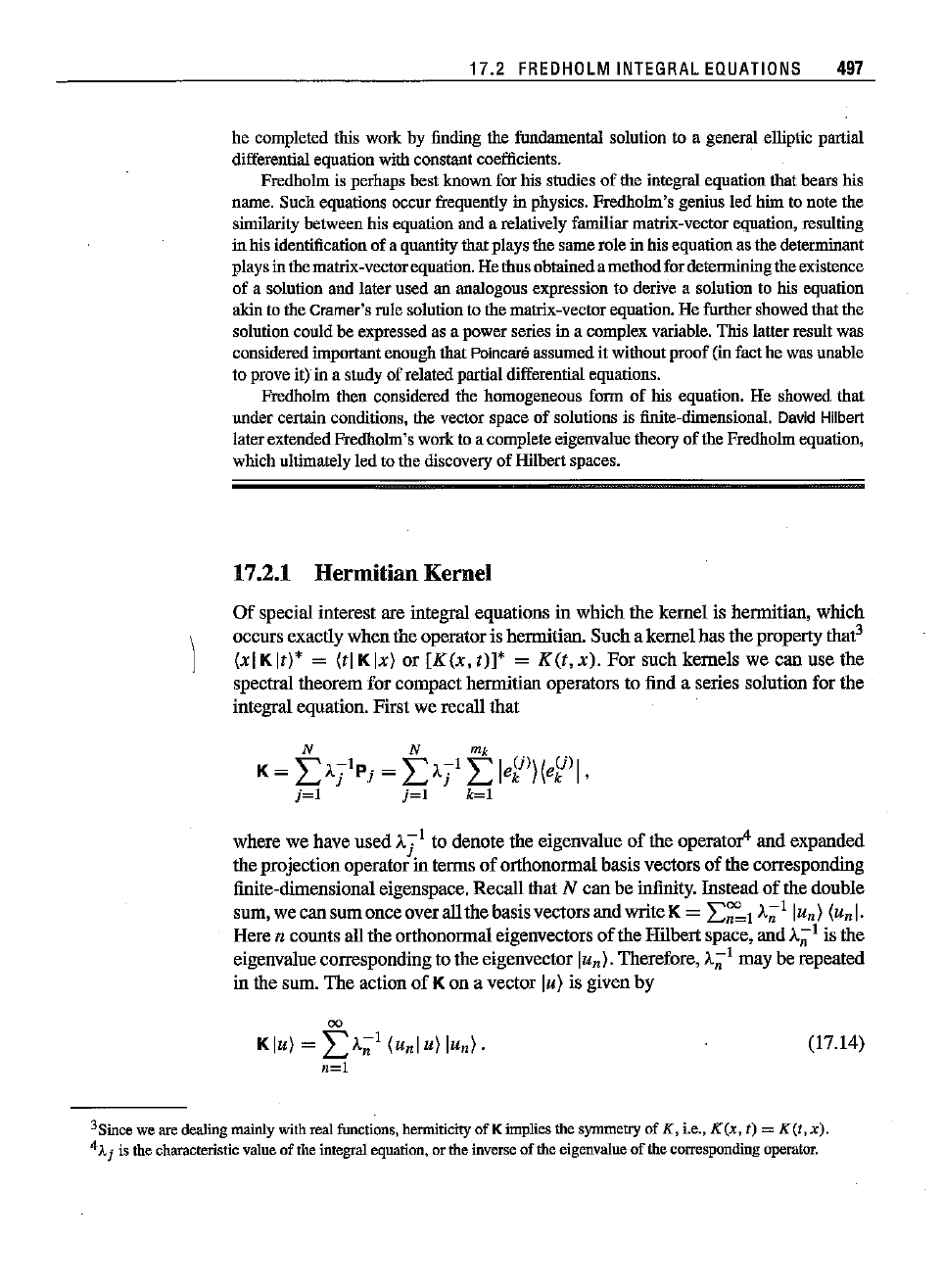
17.2
FREDHOLM
INTEGRAL
EQUATlDNS
497
he completedthis work by
finding
the fundamental solntion to a general elliptic partial
differential
equation
with
constant
coefficients.
Fredholm
is
perhaps
bestknownforhis
studies
of the
integral
equation
that
bears
his
name.
Such
equations
occur
frequently
in physics.
Fredholm's
geniusled himto notethe
similarity
betweenhis
equation
andarelatively
familiar
matrix-vector
equation,
resulting
inhis
identification
of a
quantity
that
playsthesameroleinhis
equation
asthe
determinant
playsinthematrix-vector
equation.
Hethusobtainedamethodfordeterminingtheexistence
of a
solution
and
later
usedan
analogous
expression to
derive
a
solution
to his
equation
akintothe
Cramer's
rulesolution to the
matrix-vector
equation.
He
further
showed
that
the
solution could
be
expressed
asa powerseriesin a complex
variable.
This
latter
resultwas
considered
important
enoughthat
Poincare
assumed
it
without
proof(infacthe was
unable
to
prove
it)ina
study
of
related
partial
differential
equations.
Fredholm
then
considered
the homogeneous
form
of his
equation.
He showedthat
under
certain
conditions, the vectorspaceof solutionsis
finite-dimensional.
David
Hilbert
later
extended
Fredholm's
worktoacompleteeigenvalue
theory
of the
Fredholm
equation,
whichultimately ledtothediscovery of
Hilbert
spaces.
17.2.1 HermitianKernel
Of
special interest are integral equations in which the kernel is hermitian, which
occursexactly when the operatoris hermitian. Sucha kernel has the property thar'
(r] K[r)"
= (tl KIx) or
[K(x,
t)]*
=
K(t,
x).
For
such kernels we
can
use the
spectral theorem for compact hermitian operators to find a series solution for the
integral equation. First we recall that
where we have used
J..
j
1
to denote the eigenvalue
of
the operator" and expanded
the projection operatorin terms
of
orthonormal basisvectors
of
the corresponding
finite-dimensional eigenspace. Recall that
N
can
be infinity. Instead
of
the double
sum, we can sum once over
allthe basisvectors and write K =
L:~I
J..;llu
n)
(unl·
Here n counts all the orthonormal eigenvectors
of
the Hilbert space, and J..;1is the
eigenvalue corresponding to the eigenvector
Iu
n).
Therefore, J..;I may be repeated
in the sum.
The
action
of
Kon a vector Iu} is given by
00
K
lu)
=
I>;I
(unl u) lu
n).
11=1
(17.14)
3Sincewe aredealingmainlywithreal
functions,
hermiticity
of Kimpliesthe
symmetry
of K, i.e., K (x, t) = K (t,
x).
4)"
j is the
characteristic
valueof the
integral
equation,
orthe
inverse
of theeigenvalue of the
corresponding
operator.

498 17.
INTEGRAL
EQUATIONS
If the Hilbert space is
.(,2[0,
b],we may be interested in the functional form of this
equation. Weobtain such a form by multiplying both sides by (x
I:
00 00
K[u](x)
==
(xIKlu) =
I);!
(unlu)
(xlu
n)
=
I);l
(unlu)un(x).
n=l
n=l
'
3x
(17.15)
Hilbert-Schmidt
theorem
\
That this series convergesuniformly in the interval [0, b] is known as the
Hilbert-
Schmidt theorem.
17.2.3. Example. Letus
solve
u(x)
=x +A
I:
K(x,
t)u(t)dt,
where
K(x,
t)
'"
xt
is
a
symmetric
(hermitian)
kernel,
by the
Neumann
series
method.
Wenote
that
/
IIKII
2
= l
b
l
b
IK(x,t)1
2dxdt
= l
b
l
b
x
2t
2dxdt
=l
b
x2dx
l
b
t2dt
=
(l
b
X
2dX)
2
=
~(b3
_ a
3
)2,
or
IIKII
= l
b
x
2dx
=
!(b
3
-
a
3
),
andthe
Neumann
series
converges
if
I)..
I(b
3
- a
3
)
< 3.
Assuming
that
thisconditionholds;
we have
00
lb
u(x)
= x +
I>i
Ki(x,
t)tdt.
j=l
a
The
specIal
formofthe
kernel
allows
usto
calculate
xt
(x, t)
directly:
Ki(x,t)
= l
b
t:
K(x,SI)K(s!,S2)
...
·K(si_J,t)dslds2···dsi_l
=l
bl
b···l
b
xsfs~
...
S~_ltdslds2···
dSj_l
a a a J
(
b
r
=
xt
1s2 ds = xtllKlli-
1
It
follows
that
I:
Ki
(x,
t)t
dt = xIlKlli-
1!(b
3
-
a
3
) = xllKlli.
Substituting
thisinthe
expression for
u(x)
yields
00 00
u(x) =x +
I>ixlIKlli
=x
+xAIiKII
I>i-11IKll
i-
1
j=l
j=l
=X
(I
+AIIKIII_~IIKII)
=
I-:IIKII
Becauseofthesimplicity of the
kernel,
wecansolvethe
integral
equation
exactly.
First
wewrite
u(x)
= x + Al
b
xtu(t)
dt =x +
AX
l
b
tu(t)
dt
sa
x(1
+ AA),
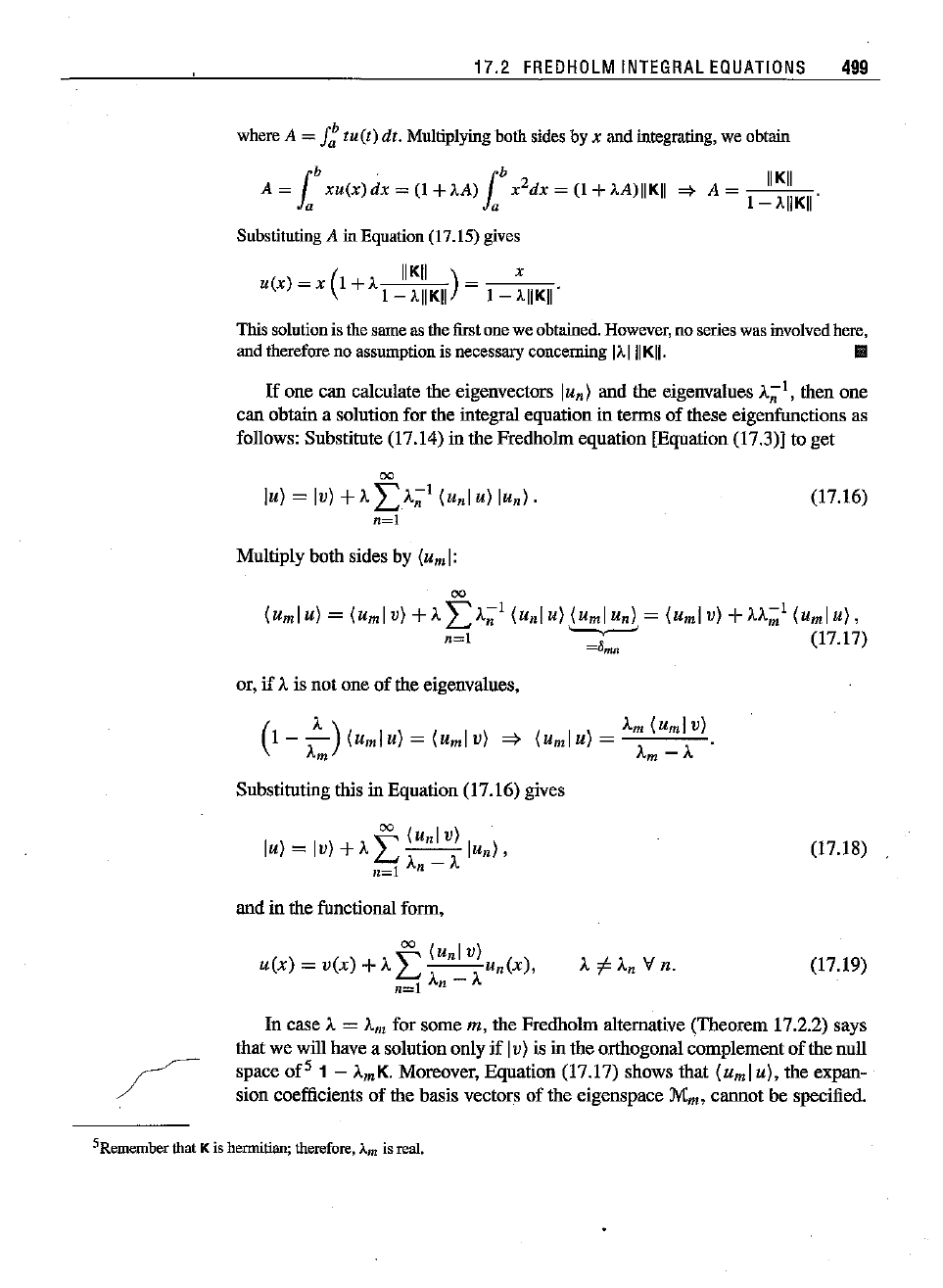
17.2
FREDHDLM
INTEGRAL
EQUATIDNS
499
whereA =
f:
tu(t) dt. Multiplying both sidesbyx audintegrating, we obtain
A = lab
xu(x)dx
= (I
+AA)
lab x
2dx
=
(I
+AA)
II
KII
=}
A = I
~~::KII
Substitutiug A in Equation(17.15)gives
_ ( A
IIKII
) _ x
u(x) - x 1+
1-
AIIKII
-
1-
AIIKII"
Thissolution is thesameasthe
first
onewe
obtained.
However,
noserieswasinvolvedhere,
and
therefore
no
assumption
is
necessary
concerning
l'AIIiKIl.
II
If
one cau calculate the eigenvectors Iun} and the eigenvalues A;;
1
,
then one
can obtain a solution for the integral equation in terms of these eigenfunctions as
follows: Substitute (17.14) in the Fredholm equation [Equation (17.3)] to get
00
lu) = Iv) +A
~:::>;;1
(unl u) Iu
n).
n=l
Multiply both sides by (u
m
I:
(17.16)
00
(uml u) = (uml v) +A
LA;;1
(unl u) (uml un) = (uml v) +).).;;;1 (uml U),
n=1
~
(17.17)
or,if
)..
is notoneof theeigenvalues.
(
I)
- Am(umlv)
Urn U - .
Am
- A
Substituting this in Equation (17.16) gives
~
(unl v)
lu} = Iv) +A
L.
A _ A Iu
n),
n=l
n
and in the functional form,
~
(unl v)
u(x)
=
v(x)
+A
L.
-r-r--r-un
(x),
n=l
An
- A
(17.18)
(17.19)
In case
A =
Am
for some m, the Fredholm alternative (Theorem 17.2.2) says
that we will have a solution only
if
Iv) is in the orthogonal complementof the null
space of
5
1 -
AmK.
Moreover, Equation (17.17) shows that (uml u), the expan-
sion coefficients of the basis vectors of the eigenspace
M
m
,
cannot be specified.
5Remember
thatKis hermitian;
therefore,
Am
isreal.

(17.20)
(17.21)
500 17.
INTEGRAL
EQUATIONS
However, Equation (17.17) does determine the rest
of
the coefficients as before.
In
this case, the solution can be written as
~
(k)
~
(u,,1v)
lu) = Iv) +
L..,
ckl
u",
} +A
L..,
A _ A lu,,),
k=l
11=1
n
n=f:.m
where r is the (finite) dimension
of
M"" k labels the
ottbononnal
basis {Iu!:»}
of
M"" and {Ck
}k~1
are arbitraryconstants.
In
functionalform, this equationbecomes
r
00
(ulv)
u(x)
=
v(x)
+
I:
CkU~~)(X)
+A
I:
_n_un(x).
k=l
11=1
An
- A
n"",
17.2.4. Example. Wenow give an exampleof the applicationof Equation (17.19).We
wantto solve
u(x)
= 3
J~1
K(x,
t)u(t)
dt
+x
2
where
and
Pk
(x)
is a Legendrepolynontial.
We
first
note
that
{Uk}
is an
orthonormal
set of
functions,
that
K(x,
t) is real and
symmetric (therefore, hermitian), andthat
1
1 dt 1
1
dxIK(x,
t)1
2
= 1
1
dt
1
1
dx t
Uk(X~U:(t)
u/(x;u;(t)
-1
-1 -1 -1
k,/=O 2 / Z /
00
1 I 1
1
1
1
=
I:
k/2172
Uk(X)U/(x) dx Uk(t)U/(t) dt
k,/=O
2 2
-I
-1
~~~~
=Okl
=clkl
001
001
=
I:
"k
8kk
=
I:
"k = 2 <
00.
k~O
Z k=OZ
Thus, K (x, t) is a Hilbert-Schutidtkernel.
Now
note that
This
ahows
that zq isaneigenfunctionof
K(x,
r) witheigenvalue
1/2
k/2.
Since3
,.
I/Z
k
/
2
for
any
integer
k,we canuse
Equation
(17.19) to write
2
00
J~1
Uk(S)s2ds
u(x)
= x +3
I:
k/2 Uk(X).
k=O Z -
3
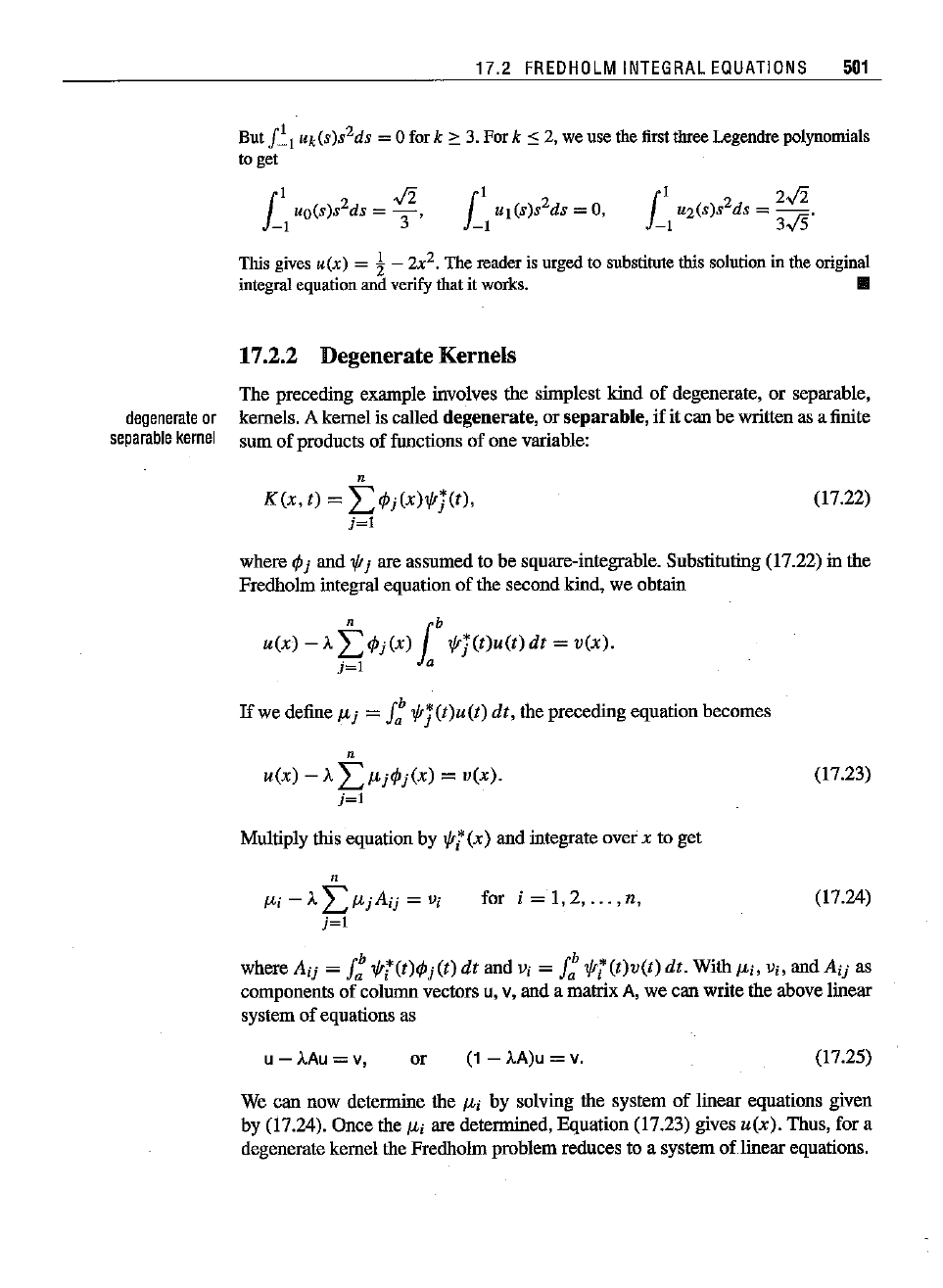
17.2
FREDHDLM
INTEGRAL
EQUATIDNS
501
But
J~I
Uk(S)s2ds =0 fork
2::
3.Fork ::: 2, weuse thefirstthree Legendrepolynomials
to get
1
1 2 ..ti
uo(s)s ds =
-,
-I
3 1
1 UI(s)s2
ds
= 0,
-I
degenerate
or
separable
kernel
Thisgives u(x) = !-2x
2
. The
reader
is
urged
to
substitute
thissolution in the
original
integral
equationandverify
that
itworks. II
17.2.2 Degenerate Kernels
The preceding example involves the simplest kind
of
degenerate, or separable,
kernels.
A kernel is called
degenerate,
or
separable,
if it cao be written as a finite
sum of products of functions of one variable:
n
K(x,
t)
=
I>/>j(x)1frj(t),
j=l
(17.22)
where
<Pj
aod 1frjare assumed to be square-integrable. Substitoting (17.22) in the
Fredhohn integral equation of the second kind, we obtain
n
lb
u(x)
- A
~
<Pj
(x) a
1frj(t)u(t)
dt
=
v(x).
If
we define f.'j =
1:
1frj(t)u(t)
dt,
the preceding equation becomes
n
u(x)
- A
Lf.'j<Pj(X)
=
v(x).
j=l
Multiply this equation by 1frt
(x)
aod integrate over x to get
(17.23)
n
f.li - A
LfJ-jAij
= Vi
j~l
for i =
I,
2,
...
,n,
(17.24)
where
Aij
=
J:
1frt(t)<pj(t)
dt
aod Vi =
J:
1frt(t)V(t)
dt.
With f.'i, Vi, aod
Aij
as
components
of
column
vectors
u,v,
and
a
matrix
A,we canwritethe
above
linear
system of equations as
u -
)"Au
= v,
or
(1-AA)u
=v.
(17.25)
We
cao
now determine the f.'i by solving the system
of
linear equations given
by (i7.24). Once the
f.'i are determined, Equation (17.23) gives
u(x).
Thus, for a
degenerate kernel the Fredholm problem reduces to a system of linear equations.
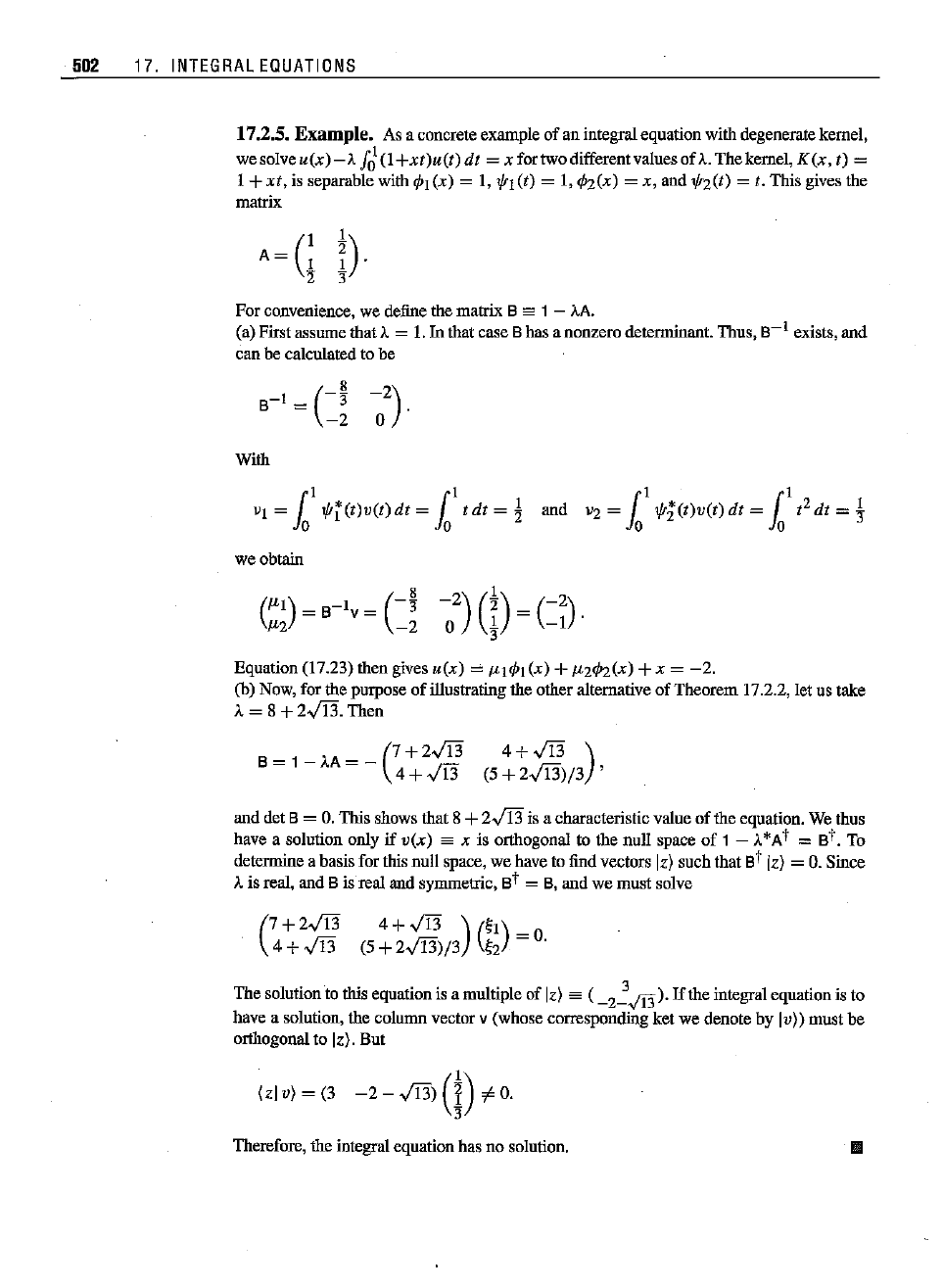
502 17.
INTEGRAL
EQUATIONS
17.2.5. Example. As a
concrete
example
of an
integral
equation
with
degenerate
kernel,
we solve
u(x)-l
fJ(I+xt)u(t)
dt
=x for two differentvalues ofA.
Thekemel,
K(x,
t) =
1+
xt,
isseparable with
9'>1
(x) = I,
1/Jl
(I)
= I,
9'>2(X)
= x, and
1/J2(t)
= t. This gives the
matrix
A=
G
t)·
2 3
Forconvenience,we definethe
matrix
Bsa 1 -
)"A.
(a)Firstassume
that)"
= 1.Inthatcase Bhasa nonzero determinant. Thus,
8-
1
exists,and
canbe calculatedtobe
With
VI = f
1/J;(I)v(t)dt
= f
tdt
=!
and "2 =
10
1
1/J
; (I)V(t) dt =
10
1
t
2dt
= j
weobtain
(
fl.I)
=
B-Iv
=
(-i
fl.2
-2
Equation
(17.23)
then gives
u(x)
=
fl.19'>1
(x) +f1.2¢2(x)+x =
-2.
(b) Now, forthe
purpose
of
illustrating theother
alternative
of
Theorem 17.2.2,letus
take
l = 8 +
203.
Then
(
7
+
203
4+
03
)
B = 1 - AA = - 4 +
03
(5 +
203)/3
'
anddetB=
O.
Thisshowsthat8 +2.../13is acharacteristic value
of
the
equation.
Wethus
havea solution only
if
vex)
==
x is
orthogonal
to thenull
space
of 1 - A*At =
at.
To
determine
abasisforthisnull
space,
we
have
to
find
vectors
Iz)such
that
at
lz)
=
O.
Since
). is real,andBisrealandsymmetric, Bt = B,andwe mustsolve
(
7
+
203
4+
03
)
«I)
4 +
03
(5+
203)/3
<2
=
O.
Thesolution to this
equation
is a multiple of lz)
==
(-2!,JI3
).lfthe
integral
equation
is to
havea solution,thecolumnvectorv (whosecorresponding ketwe denote
by Iv)) mustbe
orthogonal to lz). But
(zl v) = (3
-2
-
03)
(t)
f-
O.
Therefore,
the
integral
equationhasno solution.
III
